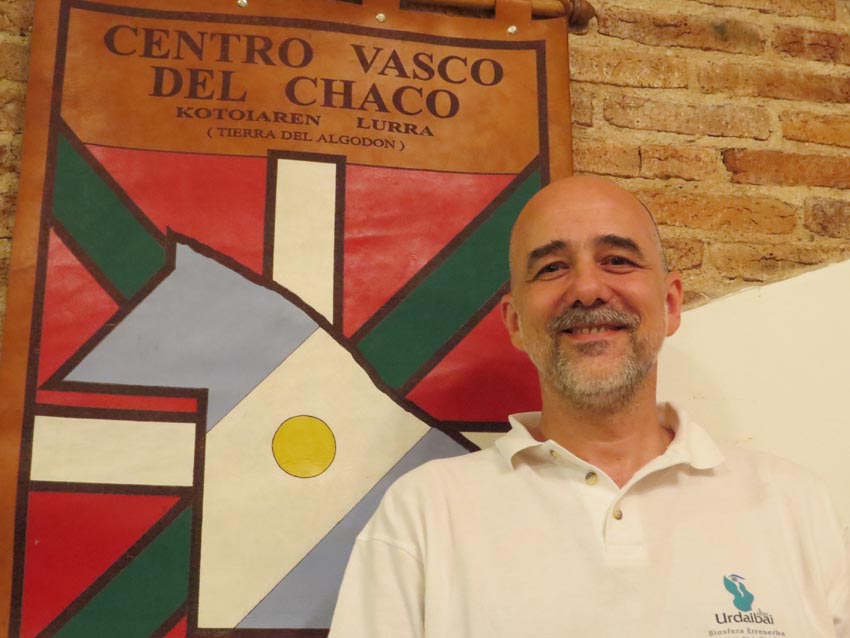Joseba Etxarri/Resistencia, Argentina. Echarri presented his book El Cura Caminador, un Vasco en El Impenetrable Argentino (The Walking Priest, a Basque in the Impenetrable Argentino) last week in Resistencia, the capital of the Argentine province of Chaco. The book is about Severiano Ayastuy Errasti (Aretxabaleta, 1914 – Chaco, 2007) who dedicated the last 20 years of his live to tour the jungle regions of Chaco, the “Impenetrable,” to help aboriginal tribes that barely live there, work done quietly that was brought to light by our interviewee in previous publications and that he delived further into in this volume, which marks the 100th birthday of the man they called the walking priest.
-How did you meet Fr. Severiano Ayastuy?
-I found out about him between 2000 and 2002, when they told me about a priest from the Basque Country that did his work in the “Impenetrable.” We need to be clear that we are talking about an area that is 600 kilometers from Resistencia and that, of those, between 200 and 300 kilometers are stretches of land that are inaccessible during the rainy season, that don’t have any infrastructure, no roads, or basic services. I am not a religious person, but when we found about the quiet work that Fr. Severiano was doing, we thought that something should be done and so we fist did a video that was presented at the 2003 World Congress of Basque Collectivities in Vitoria-Gasteiz.
-I also remember a text…
-Shortly after completing a post-graduate degree in Basque Studies at Eusko Ikaskuntza and the University of the Basque Country, I had to do a written work and I wrote onet based on the material I collected for the video. I published it with the Basque Government in its 7th volume of Vascos en el Mundo (Basques in the World).
-For someone who is unfamiliar with Chaco, what is it and what is it like?
-It is a province in northwest Argentina that became part of the institutional life of the country at the end of the 19th century when national army troops were sent in to conquer the territory where indigenous groups lived. Resistencia was founded in 1878 by a group of Italian immigrants and afterwards waves of immigrants from all over the world came, many from Eastern Europe, as well as Germans from Volga, Lebanese from Syria, Israeli, French... and of course Italians and Spanish and to a lesser extent Basques, from both sides of the Pyrenees, in addition to those that came from other parts of Argentina and Paraguay. In fact, our province is known as the “melting pot.” There was also a native population that was never referred to in censuses until the 20th century. Today we are talking about an aboriginal population that is 10%, which is roughly, a hundred thousand people out of the million inhabitants that live here.
-What is life like there?
-In very poor conditions, dependent on the State. They are not integrated. Some have created barrios in the cities. There are three main aboriginal groups, the Quom or Tobas, the Moqoit, or Mocovies and the Wichi, who were once referred to disparagingly as Matacos. The latter live in the jungle, in the “Impenetrable,” and that is where Aita Severiano shared his life with them.
-What is Chaco like today?
-It is a marginal province in Argentina, like others in the area, like Formosa, Corrientes, Santiago del Estero, Jujuy, Catamarca or La Rioja, that have been administered by a political class that was not the best. The main source of income is from primary production, we have suffered the indiscriminate felling of trees in a forest area of one hundred thousand square miles that was reduced by 70%. El Chaco was important for the cultivation of cotton and more recently of soy. But today, the main source of income is the State. Instead of carrying out policies to promote the economy and industry, the State contracts people directly today, making overcrowded offices that have more staff than work to do.
-Your Basque club will celebrate its 20th anniversary in 2016.
-We founded it on December 5, 1996 and we have had our moments, but I think that we have made interesting things. We can’t compare to the big clubs in the Humid Pampa, where there are entire cities and villages made up of people of Basque origin. Here we are a small minority in the heart of a large Italian community. Our Basque club has 250 members, not very many, but not too few either. Just consider how many Andres de Irujo prizes have been awarded in Chaco, we have two. We have published books and articles in “Euskonews,” and we have organized film series, talks, radio programs and exhibits…and obviously we get together and keep the flame alive, the spirit and Basque traditions, this is where we can compete on the same par as any of the larger Basque clubs in Argentina and the world.






 Send to a friend
Send to a friend Add comment
Add comment








